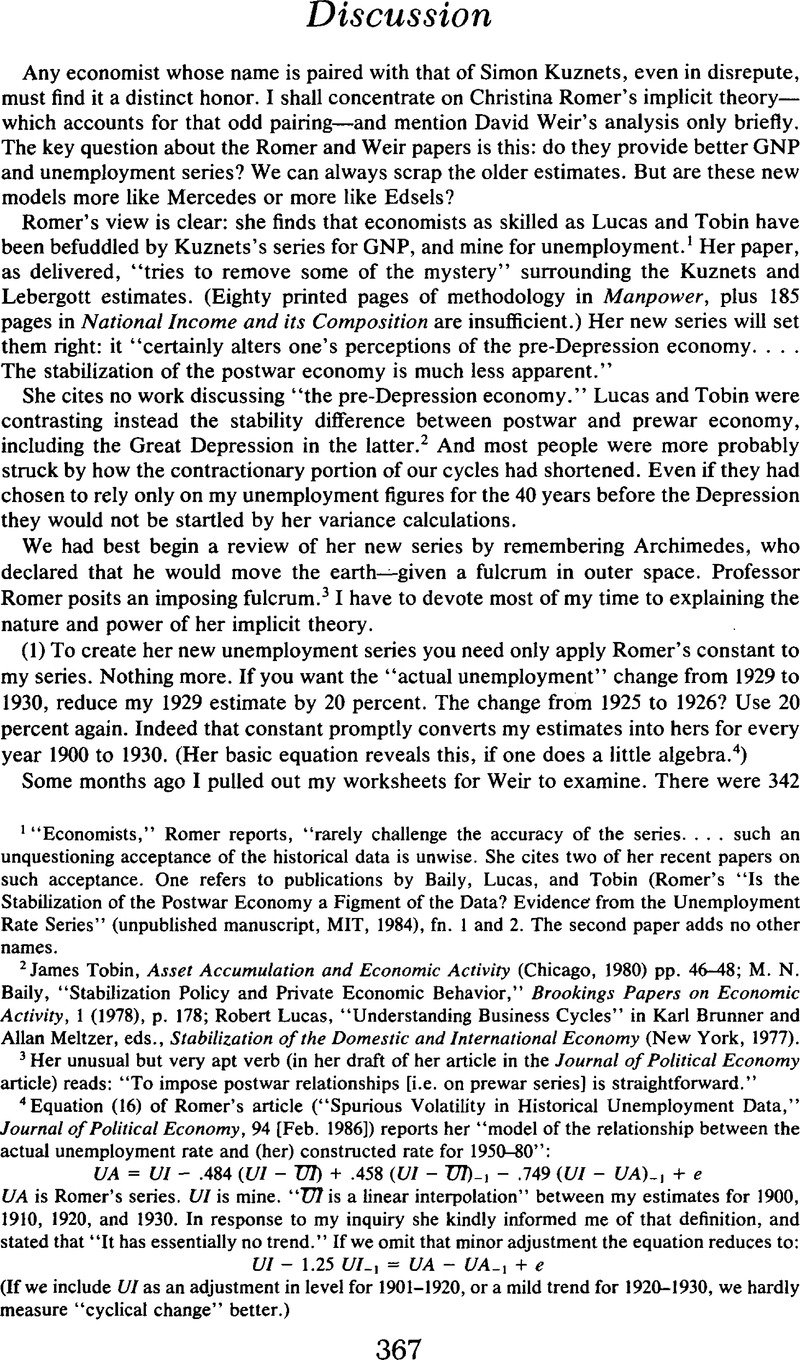Published online by Cambridge University Press: 03 March 2009

1 “Economists”, Romer reports, “rarely challenge the accuracy of the series…. such an unquestioning acceptance of the historical data is unwise. She cites two of her recent papers on such acceptance. One refers to publications by Baily, Lucas, and Tobin (Romer's “Is the Stabilization of the Postwar Economy a Figment of the Data? Evidence from the Unemployment Rate Series” (unpublished manuscript, MIT, 1984)), fn. 1 and 2. The second paper adds no other names.
2 Tobin, James, Asset Accumulation and Economic Activity (Chicago, 1980) pp. 46–48;Google ScholarBaily, M. N., “Stabilization Policy and Private Economic Behavior”, Brookings Papers on Economic Activity, 1 (1978), p. 178;Google ScholarLucas, Robert, “Understanding Business Cycles” in Brunner, Karl and Meltzer, Allan, eds., Stabilization of the Domestic and International Economy (New York, 1977).Google Scholar
3 Her unusual but very apt verb (in her draft of her article in the Journal of Political Economy article) reads: “To impose postwar relationships [i.e. on prewar series] is straightforward.”
4 Equation (16) of Romer's, article (“Spurious Volatility in Historical Unemployment Data,” Journal of Political Economy, 94 [02 1986]) reports her “model of the relationship between the actual unemployment rate and (her) constructed rate for 195–80”:CrossRefGoogle Scholar
UA = UI – .484 (UI – UI) + .458 (UI – UI)-1 – .749 (UI – UA)-1 + e
UA is Romer's series. UI is mine. “UI is a linear interpolation” between my estimates for 1900, 1910, 1920, and 1930. In response to my inquiry she kindly informed me of that definition, and stated that “It has essentially no trend”. If we omit that minor adjustment the equation reduces to:
UI –1.25 UI-1 = UA – UA-1 + e
(If we include UI as an adjustment in level for 1901–1920, or a mild trend for 1920–1930, we hardly measure “cyclical change” better.)
5 She computes annual deviations 1950–1980 from seven-year moving averages for 1945–1985. These must change whenever BEA revises its figures. (For that matter the trends will also change even if they only revise 1983–1985.) Still later BEA revisions of data for the 1970s are hardly improbable if one considers the 1929–1954, 1929–1964, 1929–1974 BEA volumes. Changes from her June 1984 estimates to the 1985 Journal of Political Economy version may reflect revisions forced by the July 1985 revision of the FRB index.
6 Table 1 of her article, this issue. She does not indicate whether her GNP cycles for measuring amplitude and so forth are defined by her series or Kuznets's. Similarly for unemployment. A “class of all classes” problem is perhaps apparent.
7 I should say “evidently omits” because she does not list her cycles nor indicate how her list(s) matches the conventional NBER list used hitherto by most macroeconomists. Few economists can have mistaken the severity of “cycles in the forty years before the Great Depression” on the basis of data for cycles defined as Romer does in Table 1. However, her “conclusion” refers to “the cycle” and to “the prewar cycle”.
8 In her words, “Thus the key assumption underlying the new estimates is that the relationship between GNP and commodity output has been stable between the prewar (1900–1930) and interwar eras.”
9 Or that the wage-hour law did alter elasticity, but that change, 1939–1949, had exactly cancelled its impact on that elasticity?
10 Weir's source is an article by Fabricant. But Fabncant adopted Carson's estimates—with very little change. What, then, about Weir's source for 1900, 1910, 1920, and 1930? For the important, cyclically sensitive, manufacturing series, Carson's 1900 estimate exceeds by 20 percent that from the Census of Manufactures. (And thus exceeds the Census of Manufactures benchmark that Fabricant used in his Employment in Manufacturing—and I also did.) But, in the three later census years Carson indirectly benchmarks to the Census of Manufactures; hence, little difference appears for those years. That is a further reason why Weir discovers a discontinuity in jobs per employee.
11 See also Lebergott, , “Labor Force and Employment, 1800–1960” in NBER, Output, Employment and Productivity in the United States after 1800 (1966) pp. 156–61. Compare also Fabricant in NBER Vol. 11, pp. 25–26.Google Scholar
12 Carson also classified saloons, hotels, restaurants in “Service.” The SIC puts them in trade, as I did for comparability with the BLS 1929ff.—hence an apparent discrepancy discovered by Weir. Carson's estimates do not allow for Prohibition's decimation in the ranks of bartenders, saloon keepers, and so forth. He interpolated for 1920 benchmarks by ratios that failed to recognize that no census publication would report a single bartender, saloon keeper, and so forth for 1920. (There may, indeed, have been few compared to 1910. [Compare Carson, , p. 108 in Volume 11.])Google Scholar
13 I had put Figure 27 together before Okun published his work, and adjusted, as he did not, for the variation in military procurement/military employment. That difference is unimportant for the present discussion.
14 The official series Kuznets used for manufacturing had been revised. The no-less important agricultural employment series required revision. A host of other changes followed. They are laboriously described in Manpower, and procedures are compared by reference to those characteristically precise notes in which Kuznets set a standard for the entire profession.
15 Kuznets, Simon, Capital in the American Economy: Its Formation and Financing (Princeton, 1961), p. 520,Google Scholar and National Income and Its Composition, 1919–1938 (New York, 1941), Tables 43, 52, p. 269;Google ScholarLebergott, Stanley, Manpower in Economic Growth: The American Record since 1800 (New York, 1964), p. 512. Kuznets estimates entrepreneurial withdrawals as equal to full-time equivalent compensation, and defines net national product as equal to national income. For 1900–1918, Kuznets's quinquennial averages and the series he uses for his annual regression derive most of their movement from Shaw's estimates. They therefore reflect chiefly deflated output by manufactures, mining, and agriculture. My employment series, on the other hand, incorporated direct estimates for employment variations in government, telephones, laundries, and so forth.Google Scholar